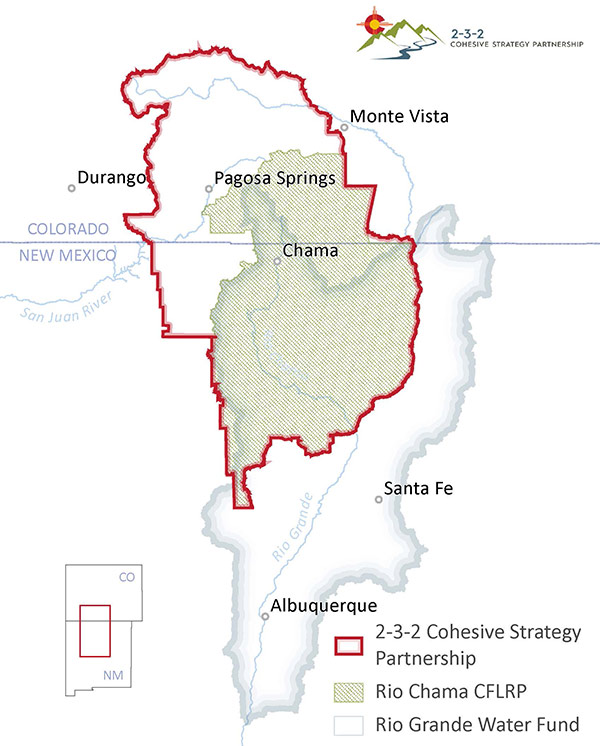By Alex Handloff
Throughout the summer and fall, forests and meeting spaces throughout northern New Mexico and southern Colorado have been filled with lively discussion surrounding the ambitious Rio Chama Collaborative Forest Landscape Restoration Program (CFLRP).
Announced in April, federal funding for the project, which covers 3.77 million acres across the region, will total $30 million over a ten-year period. The project aims to reduce the risk of uncharacteristic wildfire, restore natural fire patterns, improve watershed resilience and health and enhance the economic sustainability of industries in the region.
“I am excited to engage with our partners to brainstorm new possibilities to undertake critical restoration work across all ownerships in this project area,” says Jeremy Marshall, Rio Chama CFLRP Coordinator for the US Forest Service, “and to formulate new partnerships to achieve this work on the ground.”
The Rio Chama CFLRP is actively engaging with a variety of stakeholders and partners across the Rio Chama landscape including Tribes, state agencies, place-based collaboratives, private landowners, and forest products industry representatives, as well as the public. Project partners are currently developing monitoring plans for ecological and socio-economic objectives, defining desirable future conditions, identifying priority landscapes and supporting cross-boundary project development and implementation in the region.
The project aims to reduce uncharacteristic wildfire risk by decreasing tree densities and restoring fire regimes to fire adapted landscapes where low-intensity and mixed-severity fire were prevalent prior fire suppression policy. The suppression and absence of fire in forests of the American Southwest since approximately the 1880’s has allowed our forests to become unnaturally dense which often leads to uncharacteristically intense fire. This wildfire risk has become amplified by climate change. The CFLRP investment is focused on this landscape due to its high priority for water, wildlife, streams, and community values.
Long-term landscape scale projects hinge on innovative collaboration. The Rio Chama CFLRP is no exception, bringing together four National Forests (San Juan, Rio Grande, Carson, and Santa Fe), and the Two Watersheds, Three Rivers, Two States Cohesive Strategy Partnership (2-3-2), a diverse group of land managers, landowners, communities and existing place-based collaborative groups. Founded in 2016, the 2-3-2 approaches land management planning by bringing together stakeholders, including representatives of the US Forest Service, to prioritize, implement and monitor cross-boundary landscape-scale forest restoration projects.
“The 2-3-2 Partnership is looking forward to strengthening and growing regional and local relationships that foster collaborative work on the ground and in the office,” says Dana Guinn, Director of Forest Programs at Mountain Studies Institute (MSI), one of the organizations coordinating the 2-3-2 along with the Forest Stewards Guild. “We believe that working together is the way forward when it comes to identifying and addressing landscape values, management opportunities, and ways to monitor progress towards local and regional goals.”
This program will support the collaboration and coordination of stakeholders, application of cross-jurisdictional forest restoration treatments, development and implementation of an effective and transparent monitoring program, and direction of socioeconomic monitoring efforts to understand the beneficial impacts of the project on communities.

“We are working at a landscape-scale by bringing together land managers, landowners, and stakeholders in multiple jurisdictions to implement cross-boundary restoration in a vast landscape with a lot of interests,” says Esmé Cadiente, the Southwest Regional Director for the Forest Stewards Guild. “We know this will be challenging, but we are all committed to the shared stewardship of this landscape to support the ecological and community needs of the region.”
Along with the development of monitoring plans and desired conditions for the landscape, the 2-3-2 will coordinate and conduct projects and monitoring on non-Forest Service lands to increase the overall efficacy of the landscape approach through continuous rather than fragmented treatments. This “all-lands” approach is important because the health of private lands is critical to the overall health of the landscape.
This growing partnership also includes you, the public. Opportunities for collaboration, implementation, monitoring, and citizen science will develop in the future. Sign up for the newsletter and stay informed on all things Rio Chama CFLRP at the 2-3-2 website — 232partnership.org.
Alex Handloff is Collaborative Communications Coordinator at Mountain Studies Institute.

